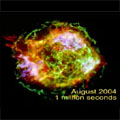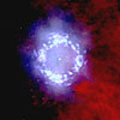CXC Home | Search | Help | Image Use Policy | Latest Images | Privacy | Accessibility | Glossary | Q&A

Three Chandra Views of Cassiopeia A
QuickTime MPEG
This sequence shows three different sets Chandra observations of Cassiopeia A. The first image is Chandra's "First Light" image, which was released in August 1999 as the observatory's first major science image. This 5,000-second-long observation then dissolves into another image created from Chandra that contained data from 50,000 seconds of X-ray data released in 2002. Finally, the new one-million-second observation of Cassiopeia A is seen, revealing spectacular new detail and complexity to the supernova remnant.
[Run Time: 0:12]
(Credit: NASA/CXC/GSFC/U.Hwang et al.)
QuickTime MPEG
This sequence shows three different sets Chandra observations of Cassiopeia A. The first image is Chandra's "First Light" image, which was released in August 1999 as the observatory's first major science image. This 5,000-second-long observation then dissolves into another image created from Chandra that contained data from 50,000 seconds of X-ray data released in 2002. Finally, the new one-million-second observation of Cassiopeia A is seen, revealing spectacular new detail and complexity to the supernova remnant.
[Run Time: 0:12]
(Credit: NASA/CXC/GSFC/U.Hwang et al.)

Supernova Remnant Animation
QuickTime MPEG When a massive star explodes, it creates a shell of hot gas that glows brightly in X-rays. This animation shows this process and depicts the stellar debris that Chandra is able to observe, revealing the dynamics of the explosion. In the case of Cassiopeia A, astronomers believe this star originally exploded approximately 320 years ago.
[Run Time: 0:16]
(Credit: NASA/CXC/A.Hobart)
QuickTime MPEG When a massive star explodes, it creates a shell of hot gas that glows brightly in X-rays. This animation shows this process and depicts the stellar debris that Chandra is able to observe, revealing the dynamics of the explosion. In the case of Cassiopeia A, astronomers believe this star originally exploded approximately 320 years ago.
[Run Time: 0:16]
(Credit: NASA/CXC/A.Hobart)
Return to Cassiopeia A (23 Aug 04)


